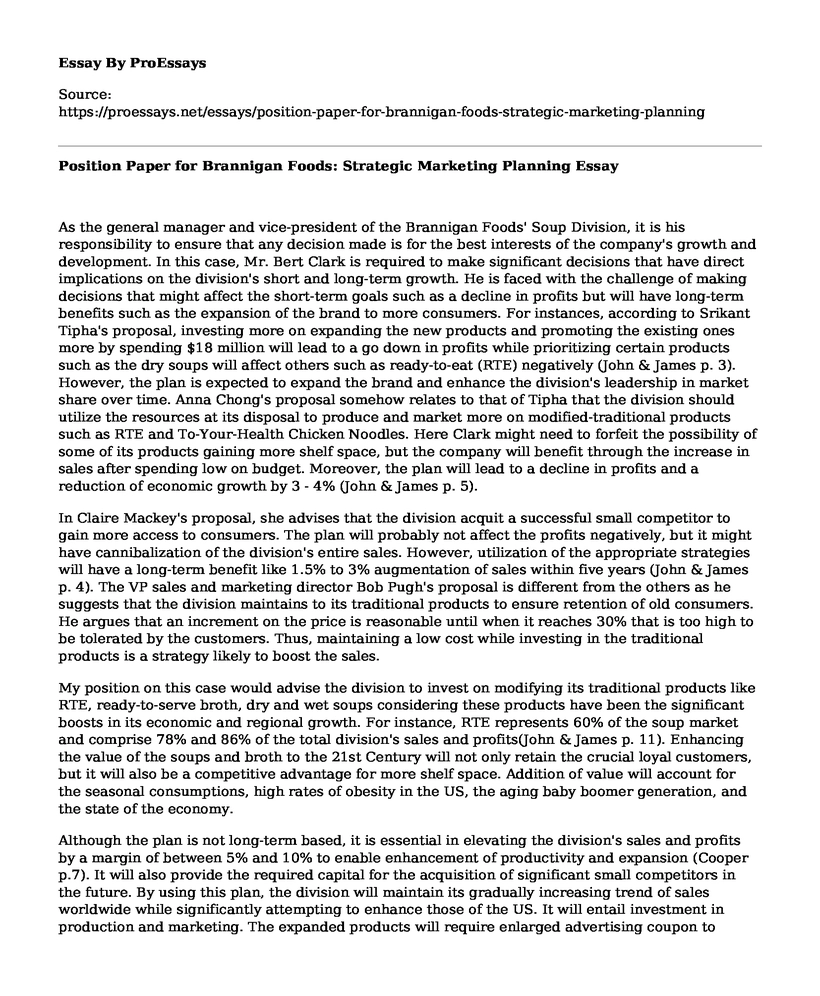As the general manager and vice-president of the Brannigan Foods' Soup Division, it is his responsibility to ensure that any decision made is for the best interests of the company's growth and development. In this case, Mr. Bert Clark is required to make significant decisions that have direct implications on the division's short and long-term growth. He is faced with the challenge of making decisions that might affect the short-term goals such as a decline in profits but will have long-term benefits such as the expansion of the brand to more consumers. For instances, according to Srikant Tipha's proposal, investing more on expanding the new products and promoting the existing ones more by spending $18 million will lead to a go down in profits while prioritizing certain products such as the dry soups will affect others such as ready-to-eat (RTE) negatively (John & James p. 3). However, the plan is expected to expand the brand and enhance the division's leadership in market share over time. Anna Chong's proposal somehow relates to that of Tipha that the division should utilize the resources at its disposal to produce and market more on modified-traditional products such as RTE and To-Your-Health Chicken Noodles. Here Clark might need to forfeit the possibility of some of its products gaining more shelf space, but the company will benefit through the increase in sales after spending low on budget. Moreover, the plan will lead to a decline in profits and a reduction of economic growth by 3 - 4% (John & James p. 5).
In Claire Mackey's proposal, she advises that the division acquit a successful small competitor to gain more access to consumers. The plan will probably not affect the profits negatively, but it might have cannibalization of the division's entire sales. However, utilization of the appropriate strategies will have a long-term benefit like 1.5% to 3% augmentation of sales within five years (John & James p. 4). The VP sales and marketing director Bob Pugh's proposal is different from the others as he suggests that the division maintains to its traditional products to ensure retention of old consumers. He argues that an increment on the price is reasonable until when it reaches 30% that is too high to be tolerated by the customers. Thus, maintaining a low cost while investing in the traditional products is a strategy likely to boost the sales.
My position on this case would advise the division to invest on modifying its traditional products like RTE, ready-to-serve broth, dry and wet soups considering these products have been the significant boosts in its economic and regional growth. For instance, RTE represents 60% of the soup market and comprise 78% and 86% of the total division's sales and profits(John & James p. 11). Enhancing the value of the soups and broth to the 21st Century will not only retain the crucial loyal customers, but it will also be a competitive advantage for more shelf space. Addition of value will account for the seasonal consumptions, high rates of obesity in the US, the aging baby boomer generation, and the state of the economy.
Although the plan is not long-term based, it is essential in elevating the division's sales and profits by a margin of between 5% and 10% to enable enhancement of productivity and expansion (Cooper p.7). It will also provide the required capital for the acquisition of significant small competitors in the future. By using this plan, the division will maintain its gradually increasing trend of sales worldwide while significantly attempting to enhance those of the US. It will entail investment in production and marketing. The expanded products will require enlarged advertising coupon to ensure more consumers are reached and lured into buying the brands (Wilson). It will also enhance the competitive advantage of the division against its rivals, and this will be a benefit in the future during acquisition. Hence, the proposal will have tackled both the short and long-term goals ultimately.
Works Cited
Cooper, Lee G. "Strategic marketing planning for radically new products." Journal of marketing 64.1 (2000): 1-16.
John Quelch A., and James Kindley T.. "Brannigan Foods: Strategic Marketing Planning." Harvard Business School (October 23, 2013): 1-12
Wilson, Richard MS. Strategic marketing planning. Routledge, 2010.
Cite this page
Position Paper for Brannigan Foods: Strategic Marketing Planning. (2022, Sep 05). Retrieved from https://proessays.net/essays/position-paper-for-brannigan-foods-strategic-marketing-planning
If you are the original author of this essay and no longer wish to have it published on the ProEssays website, please click below to request its removal:
- Cookie Production Company Analysis Paper Example
- Internationalization of Business Enterprises - Essay Sample
- Studio Zero Case Study Paper Example
- Essay Example on Joel Brady: An Impressive Strategy Director in Advertising
- Essay Example on Organizational Structures: 4 Traditional Forms
- Paper Example on Constructing Trust: Investigating the Role of Social Support in C2C Social Commerce
- Globalization's Impact: Netflix's Strategies for Success - Free Essay Sample







